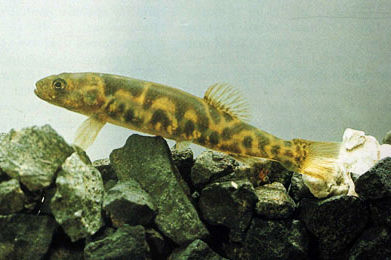Arthurs Galaxias, Paragalaxias mesotes McDowall & Fulton 1978

Arthurs Galaxias, Paragalaxias mesotes. Source: Robert M. McDowall. License: All rights reserved
A small galaxias found only in the Central Highlands of Tasmania.
Identifying features:
Body small and stout with a long blunt snout;
Overall dark greenish-brown above, extedning on sides as bands and patches over a yellowish background, belly silvery-grey:
Fins clear with faint brownish-orange pigment along fin rays.
Arthurs Galaxias, Paragalaxias mesotes McDowall & Fulton 1978
More Info
|
Distribution |
Known only from Arthur's Lake, Lake River and Woods Lake, Tasmania; also found in an artificial canal that transfers water from Arthurs Lake to Great Lake nearby. Inhabits near-shore environments, sheltering amongst rocks or vegetation; also found in pools of outlet streams. |
|
Features |
Meristic features: Dorsal-fin rays 10-13; Anal-fin rays 8-10 (usually 9); Pectoral-fin rays 13-15; Pelvic-fin rays 6; Caudal-fin rays 15; Vertebrae 40-41 Body elongate and slender; trunk cylindrical to slightly compressed; head depressed; body depth at vent 6.8-8.0; head long, sloping; snout long, blunt; mouth large, reaching just beyond front of eyes, slightly oblique; jaws equal; jaw teeth conical without enlarged canines laterally; lateral line present; open pores present on head, rows of laterosensory papillae on head and tail base; Dorsal fin short-based, rounded, inserted behind pelvic fin bases; anal fin smaller than dorsal fin, originating below rear of dorsal fin; pectoral fins of moderate size, inserted low on sides; pelvic fins of moderate size, inserted behind mid-point of body; caudal fin slightly forked to emarginate, tips rounded. |
|
Size |
To 8 cm SL, commonly to 6 cm. |
|
Colour |
Olive-green to golden overall with an irregular pattern of well defined greyish-brown patches. Fins translucent with faint pigmentation on finrays. |
|
Feeding |
Diet includes midge and caddisfly larvae, amphipods, other crustaceans and oligochaete worms. |
|
Biology |
The entire lifecycle is completed in freshwater. Clusters of eggs are spawned under boulders and are guarded until the larvae hatch. |
|
Conservation |
|
|
Etymology |
The species name mesotes is from the Greek mesotes in reference to this species being intermediate in behaviour and other characteristics between P. eleotroides and P. dissimilis. |
|
Species Citation |
Paragalaxias mesotes McDowall & Fulton, 1978, Aust. J. Mar. Freshwat. Res. 29(1): 103 figs 4, 9. Type locality: Arthur's Lake, Tasmania. |
|
Author |
Martin F. Gomon & Dianne J. Bray |
Arthurs Galaxias, Paragalaxias mesotes McDowall & Fulton 1978
References
Allen, G.R. 1989 Freshwater fishes of Australia. T.F.H. Publications, Inc., Neptune City, New Jersey.
Allen, G.R., H. Midgley & M. Allen. 2002. Field guide to the freshwater fishes of Australia: I-xiv + 1-394.
Department of the Environment and Heritage. 2005. Paragalaxias mesotes (Arthurs Paragalaxias). Available at: http://www.deh.gov.au/biodiversity/threatened/species/arthurs-galaxias.html.
Fulton, W. 1982. Observations on the ecology of four species of the genus Paragalaxias (Pisces: Galaxiidae) from Tasmania. Australian Journal of Marine and Freshwater Research 33: 999-1016.33: 999-1016.
Fulton, W. 1988. The freshwater fish fauna of Tasmania's western Central Plateau. pp. 1-23. Inland Fisheries Commission, Hobart.
Fulton, W. 1990. Tasmanian Freshwater Fishes: Fauna of Tasmania Handbook No. 7. University of Tasmania, Hobart, Tasmania.
Hardie, S.A., Jackson, J.E., Barmuta, L.A. & White, R.W.G. 2006. Status of galaxiid fishes in Tasmania, Australia: conservation listings, threats and management issues. Aquatic Conservation: Marine and Freshwater Ecosystems 16: 235-250.
Hardie, S.A., Macfarlane, K.R. & Barmuta, L.A. 2011. Life histories of galaxiid fishes in Arthurs Lake and Great Lake, Tasmania, and effects on water level fluctuations on their populations. Hydro Tasmania, Hobart. 200p.
Humphries, P. & K. Walker (eds). 2013. Ecology of Australian freshwater fishes. CSIRO Publishing. 440p.
Jenkins, A., Kullander, F.F. & Tan, H.H. 2009. Paragalaxias mesotes. In: IUCN 2012. IUCN Red List of Threatened Species. Version 2012.2. <www.iucnredlist.org>. Downloaded on 10 June 2012.
McDowall, R.M. (ed.) 1996. Freshwater Fishes of South-eastern Australia. Sydney : Reed Books 247 pp.
McDowall, R.M. 1998. Phylogenetic relationships and ecomorphological divergence in sympatric and allopatric species of Paragalaxias (Teleostei: Galaxiidae) in high elevation Tasmanian lakes. Environmental Biology of Fishes 53: 235-257.
McDowall, R.M. & Frankenberg, R.S. 1981. The galaxiid fishes of Australia. Records of the Australian Museum 33: 443-605.
McDowall, R.M. & Fulton, W. 1978. A further new species of Paragalaxias Scott (Salmoniformes : Galaxiidae), from Tasmania with a revised key to the species. Aust. J. Mar. Freshwat. Res. 29(5): 659–665
Merrick, J.R. & G.E. Schmida. 1984. Australian freshwater fishes: biology and management. Griffin Press Ltd., South Australia. 409 p.
Paxton, J.R., D F. Hoese, G.R. Allen & J.E. Hanley. 1989 Zoological Catalogue of Australia. Volume 7. Pesces. Petromyzontidae to Carangidae. Australian Government Publishing Service, Canberra. Zoological Catalogue of Australia. Volume 7. v. 7: i-xii + 1-665.
Threatened Species Section. 2006. Recovery Plan: Tasmanian Galaxiidae 2006-2010. pp. 85. Department of Primary Industries and Water, Hobart, Tasmania.



